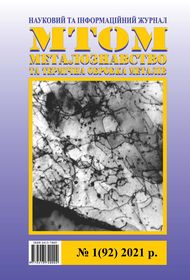Forecast of mechanical properties of metal products
DOI:
https://doi.org/10.30838/J.PMHTM.2413.230321.30.732Abstract
Introduction. The mechanical properties of the metal depend primarily on their chemical composition and structure. The structure of metal materials is formed under the influence of different temperature modes of manufacture and cooling. Models for predicting the mechanical properties of steels and cast irons are based on the influence of chemical composition and structure. The paper considers an approach that allows to evaluate the mechanical properties of rolling (C) cast iron rolls with a pearlitic (P) matrix depending on the complex influence of the elements of their chemical composition. Materials and methods. The working area of СПХН roll cast iron samples from the surface up to 50 mm doped with chromium (X) and nickel (H) was investigated. The carbide content varied from 10 to 15 %; and lamellar graphite did not exceed 2 %. The results of the experiment. In the work for modeling the mechanical characteristics of cast iron rolls used the method of planning experiments. The choice of this technique is due to the multi-parameter technology of production of solid metal casting. The application of this technique allowed to obtain models for predicting the mechanical characteristics of roll cast iron SPHN depending on the influence of the elements of the chemical composition of the rolls (C, Si, Mn, P, S, Cr, Ni). The error in predicting the tensile strength sВ, bending strength sзгин bending and hardness according to the Shore HSD method did not exceed 5,89 %. When checking the models for convergence of results by Fisher's criterion at a critical value of Fcrit = 2,400 for sВ, this coefficient was 1,249; for sзгин fold was 1,289 and for HSD - 1,012. To analyze the effect of carbon on mechanical characteristics, two-dimensional dependence plots are constructed. Conclusions. Within the operating values of the parameters of the chemical composition of cast iron rolling mills СПХН-45 in accordance with existing regulations, a forecast of their mechanical characteristics within the allowable limits of error of experimental data. The results of the work allow to obtain mathematical models in the process of production of rolls of the СПХН brand to quickly establish their chemical composition within the standard technology in accordance with the customer's requirements for these mechanical characteristics. In addition, the obtained models can predict these characteristics of the manufactured rolls with minimal material and time costs.
Keywords: rolling mills; elements of chemical composition; mechanical characteristics; multiparameter technology

Downloads
Published
Issue
Section
License
Authors that are published in this journal agree to follow the conditions:
Authors reserve the right to the authorship of his work and cede the right to the journal of first publication of this work on conditions of the license under the Creative Commons Attribution License, which allows others to distribute it freely with the obligatory reference to the author of the original work and the first publication of the work in this journal.
